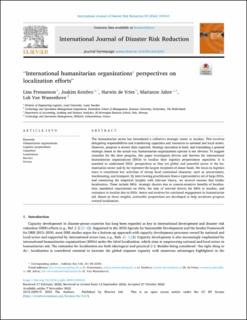| dc.contributor.author | Frennesson, Lina | |
| dc.contributor.author | Kembro, Joakim | |
| dc.contributor.author | de Vries, Harwin | |
| dc.contributor.author | Jahre, Marianne | |
| dc.contributor.author | Van Wassenhove, Luk | |
| dc.date.accessioned | 2023-02-08T13:20:19Z | |
| dc.date.available | 2023-02-08T13:20:19Z | |
| dc.date.created | 2022-12-07T10:45:55Z | |
| dc.date.issued | 2022 | |
| dc.identifier.citation | International Journal of Disaster Risk Reduction. 2022, 83 . | en_US |
| dc.identifier.issn | 2212-4209 | |
| dc.identifier.uri | https://hdl.handle.net/11250/3049328 | |
| dc.description.abstract | The humanitarian sector has formulated a collective strategic intent to localize. This involves delegating responsibilities and transferring capacities and resources to national and local actors. However, progress is slower than expected. Strategy execution is hard, and translating a general strategic intent to the actual way humanitarian organizations operate is not obvious. To suggest remedies for the slow progress, this paper investigates drivers and barriers for international humanitarian organizations (IHOs) to localize their logistics preparedness capacities. It is essential to understand IHOs' perspectives as they are global and powerful actors in the humanitarian sector and by far represent the largest recipients of donor funds. We focus on logistics since it constitutes key activities of strong local contextual character, such as procurement, warehousing, and transport. By interviewing practitioners from a representative set of large IHOs, and connecting the empirical insights with relevant theory, we unravel reasons that hinder localization. These include IHOs' strategic choices due to context-sensitive benefits of localization, mandated expectations on IHOs, the lack of internal drivers for IHOs to localize, and resistance to localize due to IHOs’ desire and motives for continued engagement in humanitarian aid. Based on these insights, actionable propositions are developed to help accelerate progress toward localization. | en_US |
| dc.language.iso | eng | en_US |
| dc.publisher | SciendeDirect | en_US |
| dc.rights | Navngivelse 4.0 Internasjonal | * |
| dc.rights.uri | http://creativecommons.org/licenses/by/4.0/deed.no | * |
| dc.subject | Humanitarian organizations | en_US |
| dc.subject | Logistics preparedness | en_US |
| dc.subject | Capacities | en_US |
| dc.subject | Localization | en_US |
| dc.subject | Barriers | en_US |
| dc.subject | Drivers | en_US |
| dc.title | “International humanitarian organizations’ perspectives on localization efforts” | en_US |
| dc.title.alternative | “International humanitarian organizations’ perspectives on localization efforts” | en_US |
| dc.type | Peer reviewed | en_US |
| dc.type | Journal article | en_US |
| dc.description.version | publishedVersion | en_US |
| dc.source.pagenumber | 0 | en_US |
| dc.source.volume | 83 | en_US |
| dc.source.journal | International Journal of Disaster Risk Reduction | en_US |
| dc.identifier.doi | 10.1016/j.ijdrr.2022.103410 | |
| dc.identifier.cristin | 2089924 | |
| cristin.ispublished | true | |
| cristin.fulltext | original | |
| cristin.qualitycode | 1 | |

